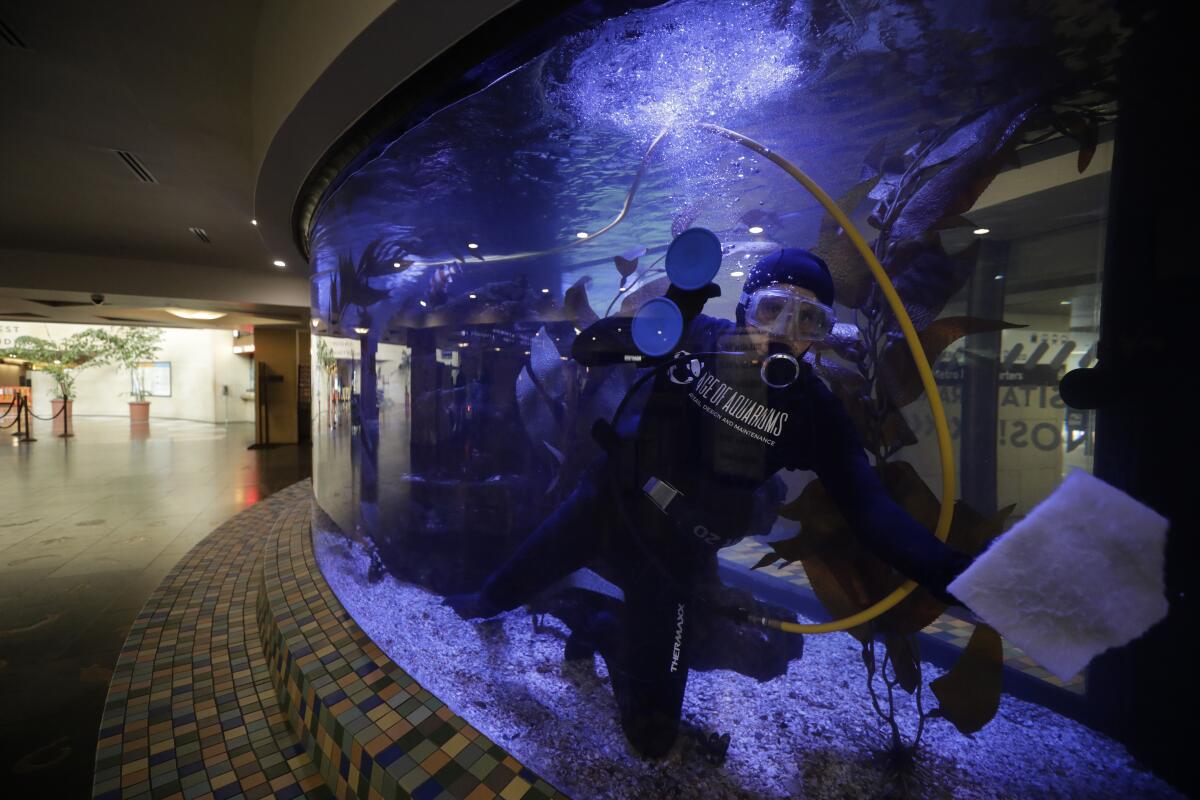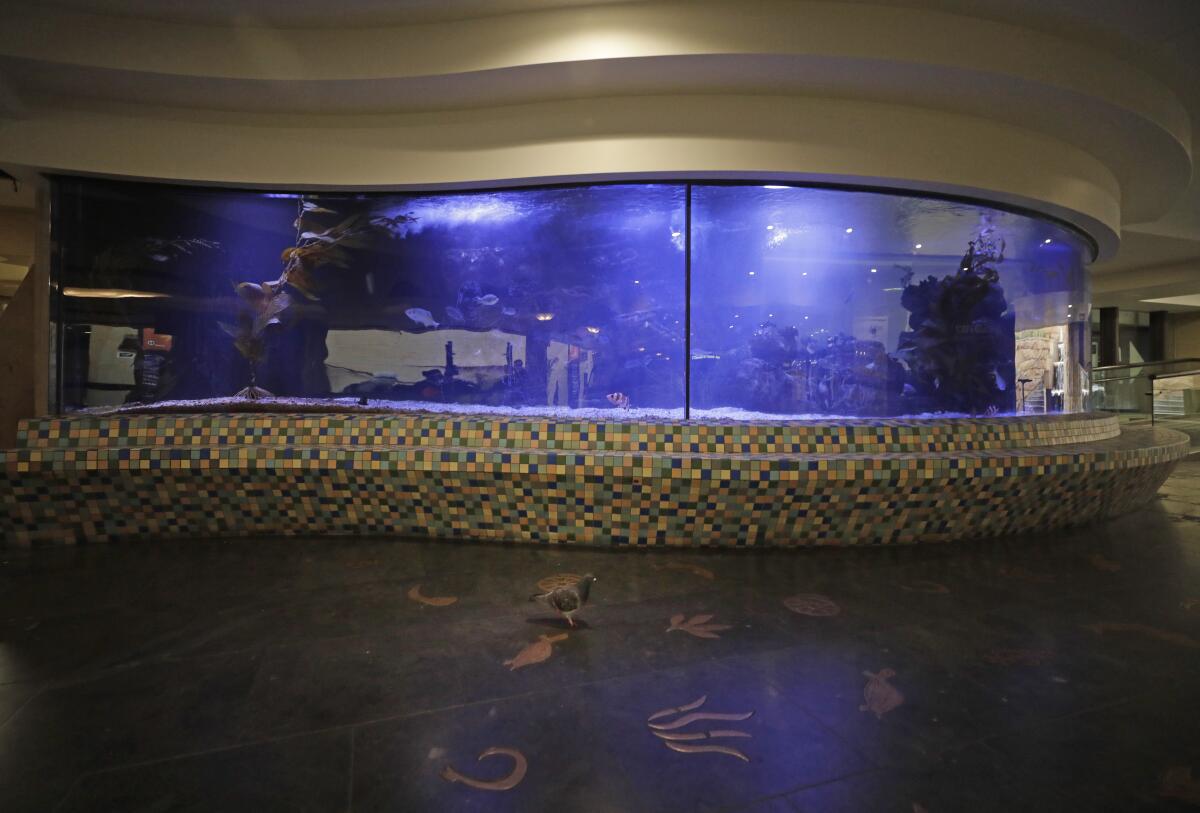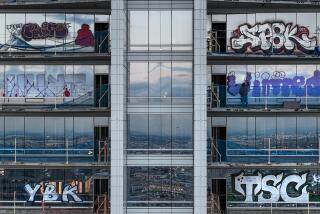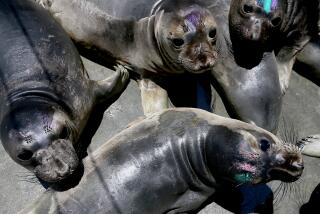In coronavirus lockdown, Union Station’s aquarium loses its fans but not its keepers

Passengers are few and the restaurants and bars have closed, but some Angelenos are still going about their everyday lives at Union Station.
Swimming, eating a bit, then swimming some more.
The skinny señorita fish, the sex-changing sheephead, the blue-gray blacksmith, schools of rockfish and a horn shark — they’re all going about their business in a 7,500-gallon aquarium at Union Station’s east portal entrance, their audience largely reduced to marine biologist Dan Gilboa, who comes every week to check on his underwater community.
“It’s eerie, no one is hanging out at all,” he said, “but I have enjoyed being underwater more than usual. I can really hear the bubbles, watch the fish swimming around. It’s a real escape from what’s going on in the outside world.”
The aquarium, marking its 25th year, is part of the installation “City of Dreams/River of History” by May Sun and Richard Wyatt, and its maintenance has been deemed essential business during the coronavirus crisis. Part of Metro’s extensive public art network, it brings a slice of California’s beloved coast right into downtown L.A.
“I wanted a saltwater aquarium to symbolize the Pacific Ocean,” said Sun, who did research at public aquariums and hired a marine biologist consultant when the plan was in its early stages.
The curve of the 40-foot-long acrylic tank was loosely based on a Native American sculpture of a whale, and Sun recalled the consultant telling her that the tail end needed to be enlarged so the fish could turn around more easily.
“I was very lucky Metro agreed to the idea, as this was a big project with a big budget,” she said of the $300,000 aquarium. The main fight she encountered on the project, she said, was over the suggestion that it feature prettier tropical fish.
“I wanted native fish,” she said.
May won that battle but, even so, color and variety aren’t lacking inside the tank. Eye-catching vermilion rockfish share the water with the state’s official marine fish, the orange garibaldi, which is Sun’s favorite.
Kept at 62 degrees, similar to the local ocean temperature, the aquarium has an acrylic wall featuring Wyatt’s etchings of early Gabrielino Indians and Latino settlers, including Pio Pico, “so that the fish swim through the people,” explained Sun.

More than 200 bronze paving inlays of native animals and plants run from the aquarium across the lobby to a second water-based sculpture. Its bench features artifacts excavated from L.A.’s original Chinatown, which was moved to make way for Union Station back in the 1930s, and is dotted with rocks from the L.A. River.
Every week, Gilboa, 61, drives from his Age of Aquariums store in Signal Hill.
“We have about 400 clients — commercial offices, private homes and celebrities — but this is such an unusual aquarium, I come myself,” he said, declining to reveal his famous customers. “It’s fun.”
A nondescript door leads to the filtration room, which is packed with shiny pipes, filters, gauges, sterilizers and boxes of sea salt.
Gilboa was joined by aquarist Ethan Valfre, 40, who divided up raw, white shrimp, Atlantic silverside, tiny orange krill and cubes of fishmeal into buckets. A single rockfish might eat four shrimp, he said, but all the fish collectively only get through about 3 pounds of food in each feeding.
Most of the fish are broadcast-fed: Food is dispersed on the water’s surface. It turns out that this seemingly peaceful underwater world can be deceptive.
Climbing a ladder, Valfre points out a separate area behind the tank that’s currently home to the horn shark. Usually pole-fed with squid, the shark had been losing weight because the pesky pair of silver halfmoon fish had been snatching his food.
“They’re getting rather dominant, and they’re very territorial,” Gilboa said.
The water level in the tank gets lowered by 200 gallons so that, on tiptoe, a wet-suited Gilboa can shout instructions. Most of the time he uses a yellow hose attached to an air compressor rather than scuba tanks to breathe during tank cleaning and maintenance. The rocks and impressive-looking Macrocystis pyrifera, or giant kelp, are artificial, but there’s always housekeeping that needs to be done. Gilboa snapped a fallen piece of coral back into place and, as always, scrubbed the gravel and cleaned the acrylic.
Gilboa, who lives in Long Beach, described himself as a water baby whose childhood passion was turtles. “But then Walter Cronkite on the evening news said they had salmonella, so my dad told me to get rid of them and I switched to fish,” he said.
Valfre, who studied marine biology in college, said these fish were collected by two aquarists from the Aquarium of the Pacific in Long Beach. He tests the salt, nitrate and pH levels and usually comes back twice more each week for additional feedings, though Gilboa has taken over that duty for now.
“These fish have been getting home food delivery for years,” Gilboa said ruefully, noting the stay-at-home orders mean others aren’t able to find the measure of peace that the fish provide.
Gilboa looks forward to the day when the coronavirus crisis is over and Angelenos and visitors passing through Union Station can see the horn shark, which has recovered in isolation and is about to be reintroduced into the exhibit.
“Kids especially are always just mesmerized by the fish,” Gilboa said with a smile, “and when they see me in there too, their eyes go wide. I can’t wait for that to happen again.”

More to Read
The biggest entertainment stories
Get our big stories about Hollywood, film, television, music, arts, culture and more right in your inbox as soon as they publish.
You may occasionally receive promotional content from the Los Angeles Times.






